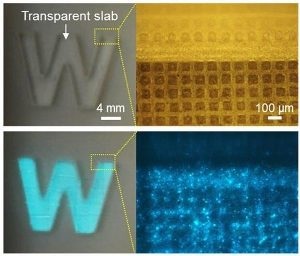Nov 2 2017
Electronic-skin technologies for robots and prosthetics are capable of detecting the slightest touch or breeze. However oddly, the sensors that do this, do not effectively respond to a harmful blow. In ACS Applied Materials & Interfaces, researchers have recently reported the development of a jellyfish-inspired electronic skin that glows when the pressure put against it is adequately high such that it can potentially cause an injury.
 An electronic skin glows when a transparent “W” is pressed onto it, and a voltage is applied (bottom). Credit: American Chemical Society
An electronic skin glows when a transparent “W” is pressed onto it, and a voltage is applied (bottom). Credit: American Chemical Society
An electronic skin that can imitate the complete range of biological skin’s sensitivity has immense potential for transforming prosthetics and robotics. Existing technologies are extremely sensitive, but just within a narrow range of weak pressures. Under high pressures capable of causing damage, the sensitivity of the electronic skin fades. Bin Hu and colleagues at the Huazhong University of Science and Technology addressed this shortcoming by turning to the Atolla jellyfish for motivation. This deep-sea, bioluminescent creature has the potential to feel changes in environmental pressure and dramatically flashes when it senses danger.
As part of building on the concept of a visual warning in response to a physical threat, the researchers joined optical and electric systems in a novel electronic skin in order to detect both high-force and slight pressures. Two layers of stretchy, poly-dimethysiloxane (PDMS) film was embedded with silver nanowires. These layers develop an electrical signal in response to slight pressures, such as those developed by a breeze or contact with a leaf. A PDMS layer embedded with phosphors is sandwiched in between the silver nanowire electrodes. This layer kicks in and then glows with increasing intensity as the physical force increases. According to the researchers, this approach more carefully copies the extensive range of pressures felt by the human skin.
The National Natural Science Foundation of China, Frontier and Key Technological Innovation Special Foundation of Guangdong Province and the Fundamental Research Funds for the Central Universities of China funded the project.